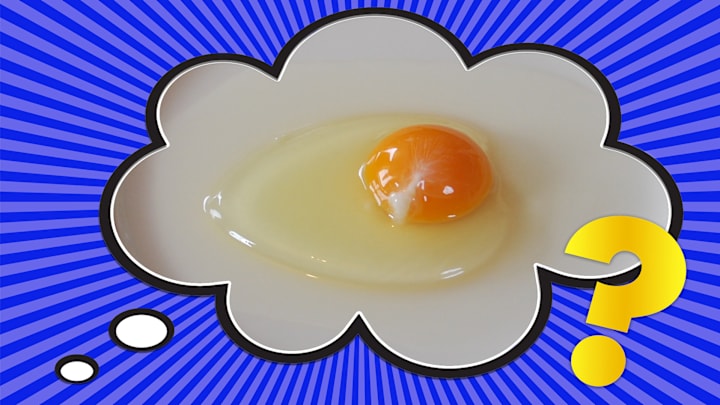When it comes to eggs, everyone knows their yolks from their whites. Fewer people can name the stringy white blob often attached to the yolk. Here’s what it is, whether you should remove it, and more things to know.
- What Is a Chalaza?
- Can You Eat the Chalaza?
- When Should You Remove the Chalaza?
- How Do You Pronounce Chalaza?
- Where Does the Word Chalaza Come From?
What Is a Chalaza?

The mysterious blobs are chalazae; a single one is a chalaza. Each egg has two chalazae: spiral bands that attach the yolk to both ends of an egg’s inner membrane, preventing it from banging around inside the shell. As Bon Appétit explains, the spirals of each chalaza are “twisted in opposite directions,” so they can’t unwind and set the yolk adrift.
Can You Eat the Chalaza?
A bunched-up chalaza can look pretty unappetizing, especially in contrast to the perfectly smooth orb beside it. But it’s totally fine to eat. In fact, an extra bright and defined chalaza is a mark of a good egg. According to the American Egg Board, Grade AA and Grade A eggs both have prominent chalazae, while those of Grade B eggs are “small or absent.”
One contributing factor is freshness. The longer an egg spends in storage, the thinner its whites will get and the more its chalazae will deteriorate. But some eggs have those characteristics from the beginning. “Younger hens tend to produce a more bouncy, obvious chalaza,” Amy Barkley, a livestock specialist for Cornell Cooperative Extension, told Bon Appétit. “Older hens have weaker, waterier egg whites in general, which makes the chalaza less prominent.”
When Should You Remove the Chalaza?
Although you don’t have to remove chalazae, certain dishes might turn out better without them—like custards, curds, and anything else that calls for smoothly whisked eggs. Bon Appétit suggests whisking eggs in a fine-mesh sieve to keep chalazae, air bubbles, and stray bits of shell out of your dish. Or you can just pick the chalazae out with a fork before you whisk.
How Do You Pronounce Chalaza?
Chalaza is pronounced “kuh-LAY-zuh.” The plural form, chalazae, is “kuh-LAY-zee.”
Where Does the Word Chalaza Come From?
Chalaza is a Latin loanword that originated from the Greek khalaza, which referred to a hailstone or any small, hailstone-like lump. Chalaza isn’t the only English word with roots in khalaza: There’s also chalazion, a type of eyelid cyst caused by blocked oil glands. Unlike styes, chalazia aren’t infected and aren’t consistently painful. And unlike chalazae, you definitely can’t remove them with a fork.
Get Answers to More Big Questions About Food:
